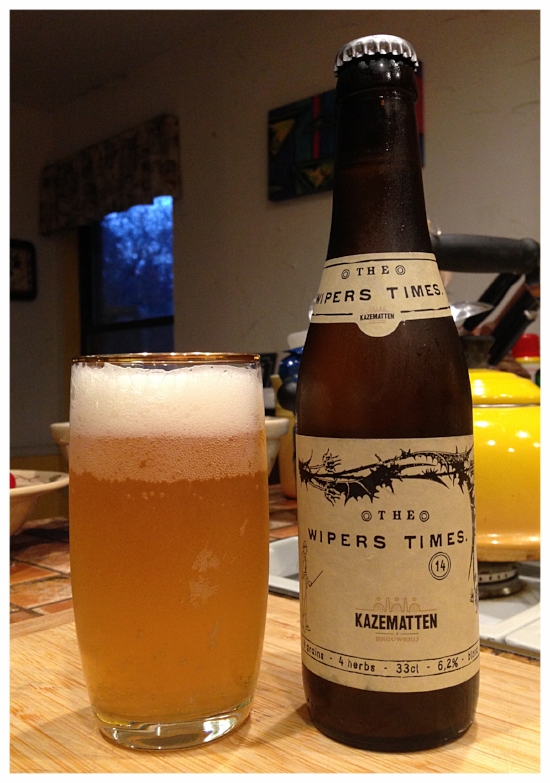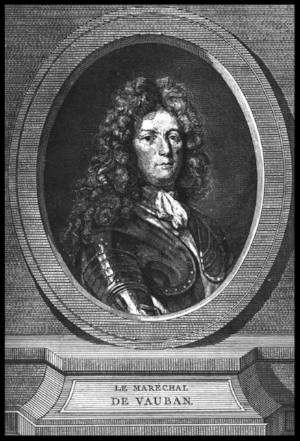1374 : The Wiper Times
The Menin Gate, located in the northeast corner of the old city of Ypres, Belgium. The old military ramparts, portions of which were built by Vauban, can be seen on either side of the gate. To find the Kazematten Brewery, one would enter the city of Ypres through this gate, then turn left and walk only a few blocks south, and you are there.
Photo: Courtesy of the City of Ypres - Tijl Capoen
One of the newer beers on the scene - The Wipers Times - from the Kazematten Brewery in Ypres, Belgium. The label says "4 grains" which are: barley, wheat, corn and oats. Also in the mix are "4 herbs" which are source locally, and include the Maria Thistle - the Blessed Thistle - which adorns the beer's label. The number "14" refers to the degrees Plato of the beer.
I must admit that when I first saw this beer a year or so ago its name certainly made me take pause - The Wiper Times. Now, in this era of thousands of microbreweries, all trying to make up catchy names for their beers, I thought to myself - "The Wiper Times"....Hmm....That's a strange name. But, it was from Belgium so I bought a four pack and started to do a little research.
The Wiper Times was the first beer produced by the Kazematten Brewery - Brouwerji De Kazematten - located in Ypres, Belgium, and I was to find out that this city, and the history of the surrounding countryside sort of gave the beer its name - well sort of directly indirectly. Founded in the Spring of 2014, the Kazematten Brewery is run by a couple of folks that bring a wealth of brewing knowledge into the picture. First is Julie Depypere, the daughter of Hans Depypere who owns the St Bernardus Brewery, and second is Maarten Ghequire, the son Rudi Ghequire who is the manager over at the Rodenbach Brewery. Julie is in charge of the administration side of the house, while Maarten tends to production. The brewmaster is Koen Hugelier.
Now for a bit of history: First, let's go all the way back to 1680, and to an engineer named Vauban (1633 - 1707), or more fully Sébastien Le Prestre de Vauban, later titled the Marquis de Vauban. Vauban entered the military as an infantryman at the age of 17, and as he rose in rank, he became quite proficient at breaching man-made fortifications, including the Siege of Gravelines (1658), the Siege of Lille (1667) and the Siege of Maastricht (1673). However, he soon specialized in the design and construction of military fortifications, and during his career he built and/or upgraded over 330 military fortresses. He was credited with the development of the "bastion wall," complete with ravelins, sally ports, curtains, caponiers, escarps, counterescarps and galleries. For a number of years Vauban worked for Louis XIV of France - the Sun King - the forces of whom conquered Ypres in 1678. It was during his tenure under Louis that Vauban oversaw, beginning in 1680, the construction of the Casemate of the Wooden Horse - Kazematten het Houten Paard - just one of the many fortifications that he built surrounding the town of Ypres.
He had many names and titles, but most simply refer to him as Vauban. He probably never imagined that his name would someday be connected with beer.
Now, a casemate, in the most general sense of the word, is a room for a gun - usually a big cannon or artillery piece - being open on one side so the gun can shoot out. Aboard a ship this room tends to be armored with metal for protection, while with in a fortress a casemate is protected by the stone/masonry/earthen structure of the fort. Over the years, the exact definition of the word "casemate" as evolved to include an entire structure of casemate-like enclosures, either a single casemate or many connected casemates, as well as all the ancillary rooms - ammunition storage, barracks, galleys, stables, etc... required to support the gun and its crew.
The Casemate of the Wooden Horse is just a portion of the larger defensive perimeter surrounding the city of Ypres. Back in the 9th Century, when Ypres was but a small village, there were the simplest of defenses, mainly consisting a strategically place piles of dirt. Over the years, these defenses were improved upon, destroyed in various conflicts and rebuilt again. In the 13th Century, Countess Joahanna van Constantinopel (c.1194-1244) improved the works to include large stone gates and a system of moats. In 1640, when the Spanish held Ypres, the wall around Ypres was still basically an earthwork mound, along with a number of gates. Then, as previously mentioned, the whole system was upgraded by Vauban, when Ypres - now a major trading center - was under French control, to the masonry structure we see today. The reference to the "Wooden Horse" seems a bit mysterious, although one source says it could be a nod to the Trojan Horse. It should be noted that much of the city of Ypres, including its ancient defensive wall, was damaged, in not outright destroyed, during the First World War. Today, the Kazematten Brewery, as the name suggests, is located within the old Kazematten het Houten Paard.
So, now that we know where the Kazematten Brewery is located, and why it is called such, let's see why the beer "The Wiper Times" is called by that name.
From the book "In The Ypres Salient - The Story of a Fortnight's Canadian Fighting, Jun 2-16, 1916," by Beckles Willson (published in 1916), a map shows the town of Ypres and one of the main areas of fighting - note the trenches just a few miles from the town. (You are northwest of the town, looking to the southeast.) Note also the Port de Menin - The Menin Gate, and the "Kasteelgracht" ( usually written as two words - Kasteel Gracht. A kasteel was a defensive structure, while a gracht was a defensive moat or canal), Although not defined more precisely, the kasteel shown here is most likely part of the Casemate of the Wooden Horse.
The first issue of The Wiper Times - 1916. The "trench newspaper" was also called The Salient News, a nod to the fact that the soldiers were manning the Ypres Salient. This image is from a old book, with an introduction by Captain Frederick Roberts, which contains copies of many of the issues of the newspaper.
Imagine, if you will, that you are a young English soldier heading south to the Continent to fight in the First World War. Not having paid much attention in school to European geography, when you are told that you are going to the front near the town of Ypres, Belgium, you exclaim, "What, say that name again!" Totally giving up on trying to correctly pronounce the name, you simply default to pronouncing it like it is spelled - "Wipers."
Ask anybody who has been in the military - both in peacetime and conflict - and they will tell you that military life tends to be a few periods of intense activity interspersed with long periods of inactivity - hurry up and wait. Even during some of the most intense times military people often manage to find something distinctly non-military to do, and thus the founding of "The Wiper Times" newspaper.
Known as the Yorkshire Trench - part of the military emplacements in the area around Ypres - as seen today.
Photo: Courtesy of the City of Ypres - Tiji Capoen
Captain Frederick J Roberts was an officer in the 12th Battalion - the Sherwood Foresters - an infantry unit in the British Expeditionary Force (B.E.F.). In early 1916, Captain Roberts and his fellow infantrymen were stationed on the lines near the town of Ypres, and it was during a patrol through the town that the men stumbled upon a disused old printing press in a printing office located on the main square. Captain Roberts exclaimed, "Some printing-house and some square." There were only a couple of walls of the building still standing, while the rest of the building had collapsed on the actual press itself, the result of incessant German shelling of Ypres. He recalled that the actual metal letter type pieces were scattered "all over the countryside." Still, one of the sergeants - unfortunately his name is lost to time - was a pressman in his civilian days and upon seeing the old printing press an idea was born.
One of the satirical adverts in The Wiper Times offering something that every soldier needs on the front lines - a combination umbrella & wire cutter.
Printed by the Sherwood, Forester and Company (a nod the the name of their infantry unit), and titled "The Wiper Times," or "The Salient Times" (a salient being a description of a fortified military line), the first issue of this "trench newspaper" came out on 12 February 1916. It was a mix of fact and fiction, but was mostly a somewhat ribald lampoon of the soldier's current situation. Captain Robert recalled, "To get an idea of the birth of the paper one has to try to visualize Wipers in those early days of 1916. We lived in rat-infested, water-logged cellars by day and at Hooge [a nearby village on the lines] by night. As an existence it had little to recommend it. The editorial den was a casemate under the ramparts built by Vaubin (sic) - heaven alone knows when! Though why the dear old bird [Vauban] built a wall fifty feet thick to keep out grape-shot - or whatever the Hun of the day threw around - is hard to say. However, God rest his soul! He gave us the only moments of security we had for three long months, and often we drank to his shadow."
The first print run of "The Wiper Times" was 100 copies, which quickly ran out. Demand called for next few print runs to be upped to 200 copies. Over the ensuing months, as the unit changed its location due to the tides of the war, the newspaper changed its name to match - "The New Church Time," "The Sommes Times," etc... The final issue, now titled "The B.E.F. Times," was printed in late 1918, as the war came to a conclusion. "The Wiper Times" was published during very dark and terrifying days for the British soldier on the from lines, and Captain Roberts notes of the humor presented in the newspaper, "Remember that the hilarity was more often hysterical than natural."
The good Platoon Commander also appears on the label of Kazematten Brewery's The Wiper Times beer.
According to Captain Roberts, this illustration was made from a woodcut stamp carved by the mentioned Sapper Couzens, while he was hunkered down in a trench then under German bombardment.
Home of the Kazematten Brewery - the Belgian city of Ypres, seen here on a circa 1916 vintage map.









